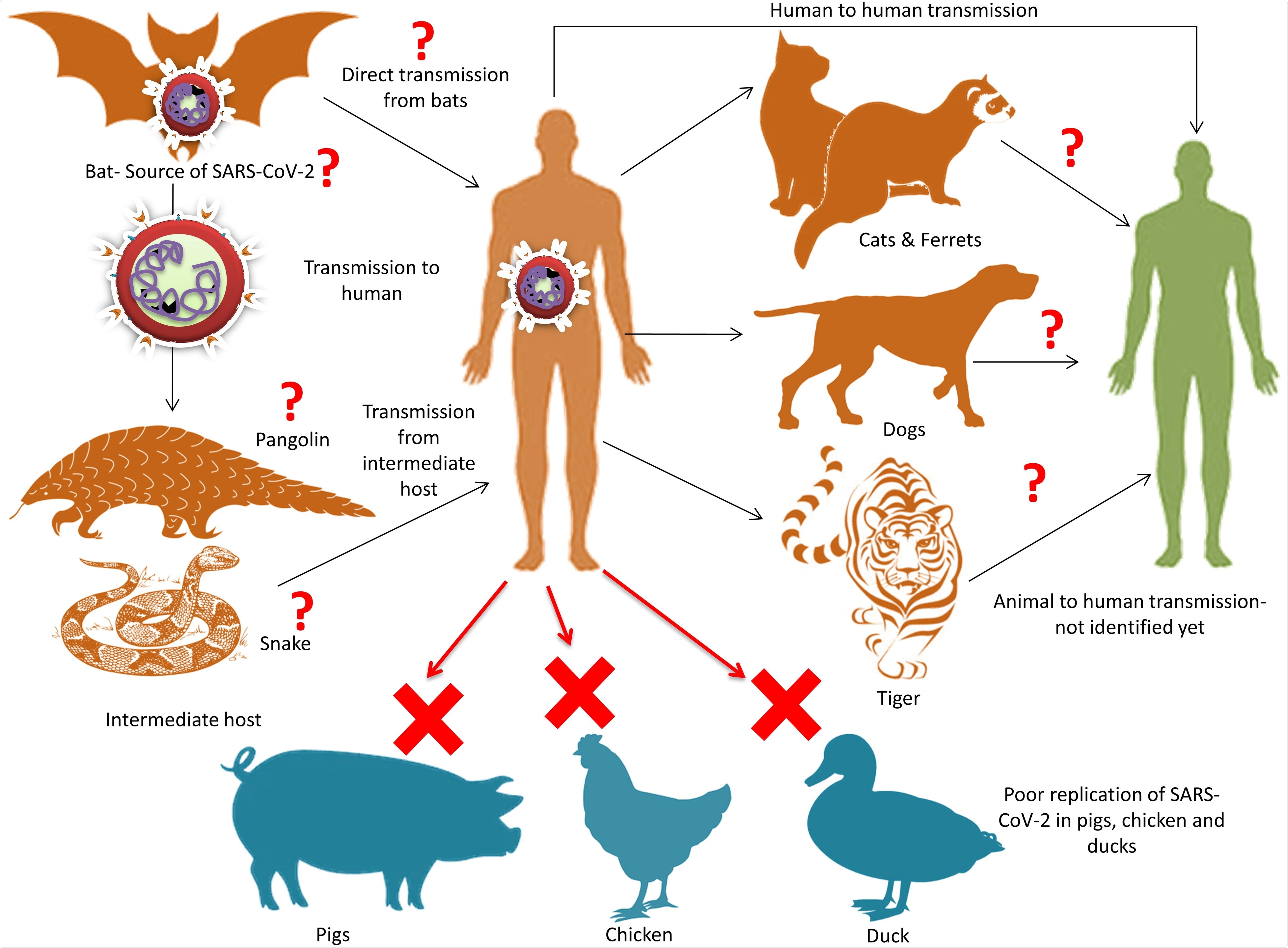The coronavirus disease (COVID-19) pandemic is thought to have originated from a live-animal market in Wuhan City, China. From there, it has spread worldwide, infecting over 64.36 million people and claiming the lives of nearly 1.5 million.
A team of researchers at the ICAR-Indian Veterinary Research Institute explored the role of animals, the veterinary, and associated zoonotic links of SARS-CoV-2 and prevention and control strategies based on 'One Health' approaches. The research is published in the journal Veterinary Quarterly.
One Health is a collaborative, multisectoral, and transdisciplinary approach, working at the local, regional, national, and international levels to achieve optimal health outcomes that recognize the interconnection between people, animals, plants, and the environment.

Zoonotic links of SARS-CoV-2. Bat has been reported as the reservoir source of SARS-CoV-2. The intermediate host is not yet elucidated clearly and presently snake and/or pangolins are reported to the intermediate host. Reports regarding the transmission of SARS-CoV-2 from human to animal have been speculated. Study also shows that SARS-CoV-2 replicate poorly in pig, chicken and duck while ferrets and cats are susceptible.
The coronavirus pandemic
In December 2019, a cluster of infections was reported in Wuhan City, Hubei Province in China. Doctors report pneumonia-like illnesses similar to the severe acute respiratory syndrome (SARS) illness in 2002.
By January 2020, health experts identified the mysterious lung disease's causative agent, the novel coronavirus or 2019-nCoV. The virus's name was subsequently changed to SARS-CoV-2, and by March, the World Health Organization has declared the outbreak as a worldwide pandemic.
To date, SARS-CoV-2 is considered the seventh coronavirus that infects humans, along with HKU1, OC43, NL63, 229E, the severe acute respiratory syndrome coronavirus (SARS-CoV), and the Middle East respiratory syndrome coronavirus (MERS-CoV). SARS-CoV and MERS-CoV are zoonotic and have resulted in high mortality outbreaks in the last two decades. The HKU1, OC43, NL63, 229E viruses are cause mild upper-respiratory tract illnesses such as common colds.
Animal source
Nearly a year into the pandemic, there is still no precise evidence showing where the virus came from. The circumstantial evidence that ties the first COVID-19 case to the Huanan South Seafood Market that sells various exotic live animals made scientists conclude the potential zoonotic transmission in SARS-CoV-2.
Past coronavirus outbreaks provide evidence that coronaviruses can cross the species barrier. Hence, SARS-CoV-2 may have come from an animal source, too.
Identifying the origin of SARS-CoV-2 will help shed light on the exact mechanism responsible for its initial transmission. This can help countries prepare for future outbreaks and prevent its spread.
The seafood market in Wuhan City is famous for restaurants that offer various small and large domestic animals, wild animals, and live animals, including poultry, bats, rabbits, snakes, turtles, pangolins, hedgehogs, marmots, and badgers for human consumption.
When SARS-CoV-2 started to spread, it was assumed that it had been transmitted from animals to humans, followed by sustained human-to-human transmission. Past studies have shown that bats were involved in transmitting severe acute respiratory syndrome (SARS) and the Middle East respiratory syndrome (MERS). Hence, scientists focused on the role of bats as the origin of SARS-CoV-2.
At present, it is understood that the SARS-CoV-2 is closely related to the bat coronavirus, which has been isolated from horseshoe bat. It was also shown that there is an intermediate host that allowed the transfer of the virus to humans from bats. The intermediate host is not yet cited, and presently, reports point to snakes or pangolins as potential intermediate hosts.
Prevention of outbreaks
Until the vaccines are developed against SARS-CoV-2, countries should focus on disease prevention and control strategies. Governments must strengthen infrastructure and capacity building with a trained workforce and health workers to detect patients infected with the coronavirus immediately.
This allows for early isolation and testing of patients infected with the virus.
"To apply any prevention, measure the first and foremost step is to diagnose the case with accuracy and speed," the researchers added.
Further, the researchers said that the permanent ban on the wild animal trade should not be implemented. It will only shift the trade to the black market. It is crucial to regulate the trade of wild animal species rather than going for a complete ban.
"The emergence of newer zoonotic infections like SARS-CoV-2 is inevitable in the future. Hence, local and international regulatory authorities need to develop and implement robust disease control mechanisms that effectively decrease the possibility of human exposure to wild animals," the researchers added.
Source:
Journal reference: